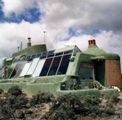
Incorporating green architecture into an existing home – Checklist
Sustainable homes are those that incorporate sustainable or recycled building materials into the design. They also use renewable energy sources wherever possible, and rely on eco-friendly furnishings, paints, appliances, and cleaning products. Residents of sustainable homes also often try to incorporate sustainable living into their everyday lives. They look for new ways to shrink waste, conserve energy, and reduce their carbon footprint. Here are a few items to consider:
GENERAL DESIGN
Smaller is better: Optimize use of interior space through careful design so that the overall building size and resource use in constructing and operating it are kept at a minimum.
Design an energy-efficient building: Use high levels of insulation, high-performance windows, and tight construction. In Southern climates, choose glazing with low solar heat gain.
Design buildings to use renewable energy: Passive solar heating, day lighting, and natural cooling can be incorporated cost-effectively into most buildings. Also consider solar water heating and photo-voltaic — or design buildings for future panel installation.
Optimize material use: Minimize waste by designing for standard sizes. Avoid waste from structural over-design (use optimum value-engineering/advanced framing).
Design water-efficient, low-maintenance landscaping: Conventional lawns have high impact because of water use, pesticide use, and pollution generated from mowing. Design your landscape with drought-resistant native plants and perennial groundcovers.
Recycle waste: Make provisions for storage and processing of recyclables: recycling bins near the kitchen, under sink, door mounted bucket with lid for compostable food waste, etc.
Look into the feasibility of gray water and rooftop water catchment systems: Water that has been used for bathing, dish washing, or clothes washing can be recycled for flushing toilets or irrigation. Rooftop water catchment for outdoor watering should be considered in many regions.
Avoid potential health hazards (radon, EMF, pesticides): Follow recommended practices to minimize radon entry into the building and provide for future mitigation if necessary. Plan electrical wiring and placement of electrical equipment to minimize electromagnetic field exposure. Design insect-resistant detailing that will require minimal use of pesticides.
SITE DESIGN
Pay attention to solar orientation: Reduce energy use by orienting buildings to make optimal use of passive solar heating, day lighting, and natural cooling.
Situate buildings to benefit from vegetation: Trees on the east and west sides of a building can dramatically reduce cooling loads. Hedge rows and shrubbery can block cold winter winds or help channel cool summer breezes into the building.
MATERIALS
Avoid ozone-depleting chemicals in mechanical equipment and insulation.
Use durable products and materials: A product that lasts longer or requires less maintenance usually saves energy. Durable products also contribute less to our solid waste problems.
Use building products made from recycled materials: They reduce solid waste problems, cut energy consumption in manufacturing, and save on natural resource use.
Avoid materials that will give off gas pollutants: Solvent-based finishes, adhesives, carpeting, particleboard, and many other building products release formaldehyde and volatile organic compounds (VOCs) into the air. These chemicals can affect workers’ and occupants’ health as well as contribute to smog and ground-level ozone pollution outside.
EQUIPMENT
Install high-efficiency heating and cooling equipment: Well-designed high-efficiency furnaces, boilers, and air conditioners not only save the building occupants money, but also produce less pollution during operation.
Install high-efficiency lights and appliances: Fluorescent lighting has improved dramatically in recent years and is now suitable for homes. High efficiency appliances offer both economic and environmental advantages over their conventional counterparts.
Install water-efficient equipment: Water-conserving toilets, showerheads, and faucet aerators not only reduce water use, they also reduce demand on septic systems or sewage treatment plants.
Install mechanical ventilation equipment: Mechanical ventilation is usually required to ensure safe, healthy indoor air.